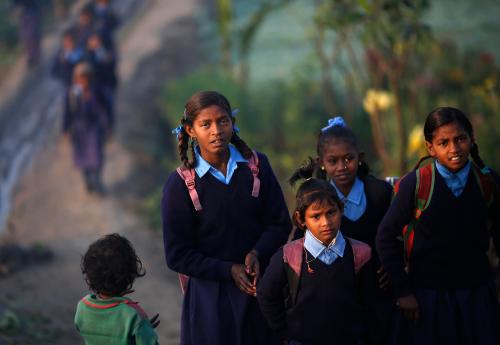March 18 was an historic day for early childhood development (ECD) financing—the Departments of Social Development and Health of the Western Cape province of South Africa committed 25 million rand ($1.62 million) in outcome funding for three social impact bonds (SIBs) for maternal and early childhood outcomes. This is the first ever funding committed by a middle-income government for a SIB—to date no low-income country governments have participated in a SIB either—making South Africa’s choice to pioneer this new path especially exciting.
A SIB is a financing mechanism for social outcomes where investors provide upfront capital for services and a government agency repays investors contingent on outcome achievement. There are currently two active development impact bonds or DIBs (where a donor provides outcome funding rather than a government agency) in middle-income countries, one for coffee production in Peru and one for girls’ education in India. The South African SIBs, whose implementation was facilitated by the Bertha Centre for Social Innovation and Entrepreneurship at the University of Cape Town and Social Finance U.K. as well as other organizations, will be the first impact bonds in Africa.
We have been following closely the development of these SIBs over the last two years through our research on the potential applications of impact bonds for ECD outcomes, and recently hosted a discussion on the topic at Brookings. There are currently nine other impact bonds worldwide that include outcomes for children ages 0 to 5, including two recently announced impact bonds in the U.S. for nurse home-visiting in South Carolina and support for families struggling with substance abuse in Connecticut.
Impact bonds are well suited to fund interventions that have high potential returns to society; that require learning, adaptability, and combinations of services to achieve those returns; and that are not core government-funded services (often resulting in a relative proliferation of non-state providers). In our recent report, we find that a majority of evaluations show ECD can have unparalleled returns, but there are also a number of evaluations that show no significant impact or where impact fades out. Overall however, there are few evaluations relative to the number of service providers and interventions, an indication of how little we know about the effectiveness of the majority of service providers. For example, there are only 15 studies examining the effects of ECD interventions in low- and middle-income countries on later-life socioemotional development, which has been shown to be a critical determinant of success in school and life.
The case for government investment is strong, but continuous learning and adaptation is needed to ensure the high potential impacts are achieved. Tying payments to outcomes could help the ECD sector in three ways: it could encourage new government investment in ECD, it could encourage performance management and adaptability, and, crucially, it could help develop the knowledge base of what works in ECD. Unlike some other sectors where providers are able to finance their own operations to participate in a results-based (performance-based) contract through fees or other cash flows, ECD providers will almost always require upfront capital in order to reach the most vulnerable. Consequently, we find that, despite some significant challenges, ECD interventions are particularly well suited to impact bonds.
For this reason, there are three things we find particularly exciting about these new SIBs for early childhood development in South Africa:
-
- Collaboration of two departments to ensure a continuity of outcome measurement and, hopefully, achievement. Given their different mandates, the Department of Health will fund outcomes for pregnant mothers and children in their first 1,000 days and the Department of Social Development will fund outcomes for children ages 2 to 5. The Bertha Centre writes that “the funding will be made available to three community based organizations working with pregnant women and children up to five years of age with outcomes including improved antenatal care, prevention of mother to child transmission of HIV, exclusive breastfeeding, a reduction in growth stunting, and improved cognitive, language and motor development.”
The continuity of quality services is essential to sustaining the impacts of early childhood services, and this is the first set of impact bonds to address outcomes across the development spectrum from age 0 to 5. Selecting outcomes however, particularly for more complex learning outcomes for children ages 3 to 5, can be one of the greatest challenges for impact bonds in the ECD sector.
A full list of recommended outcome metrics for ECD impact bonds is available in our report.
-
- Outcome fund structure. The SIBs in South Africa have been designed as impact bond funds, where the outcome funder issues a rate card of prices it is willing to pay for certain outcomes and multiple service providers are awarded contracts to provide those outcomes. This structure, which has been implemented in four instances in the U.K., could help facilitate impact bonds at greater scale than what we have seen thus far.
At the Brookings event on impact bonds, Louise Savell of Social Finance U.K., explained that scale was critical in the South African case because there are few providers that work across the entire province. While the discussion around pricing outcomes in the U.K. was more focused on future value to the economy, the discussion in South Africa had to be more attuned to the price of providing services. These delivery prices differ greatly by township, which may result in different outcome payment prices by township. The impact bond designers also had to ensure the outcome price allowed for providers to serve the hardest to reach.
- Matching of private-sector outcome funds. This is the first impact bond to date where private-sector actors will augment outcome funds, in addition to serving as investors. Impact bonds take a great deal of work for a government agency to establish—though it will likely drop over time—and additional or matching of outcome funds will be critical to making this effort worthwhile for low- and middle-income country governments.
Looking forward, it will be interesting to compare and contrast the structure and design of these SIBs with the impact bonds for ECD outcomes in Cameroon, India, and potentially other countries as they launch in the coming years. Each impact bond must be designed taking into consideration the particular issues and challenges in a given context. However, sharing learnings from one impact bond to the next will likely improve both efficiency and quality of the impact bond implementation.





Commentary
South Africa is the first middle-income country to fund impact bonds for early childhood development
April 6, 2016